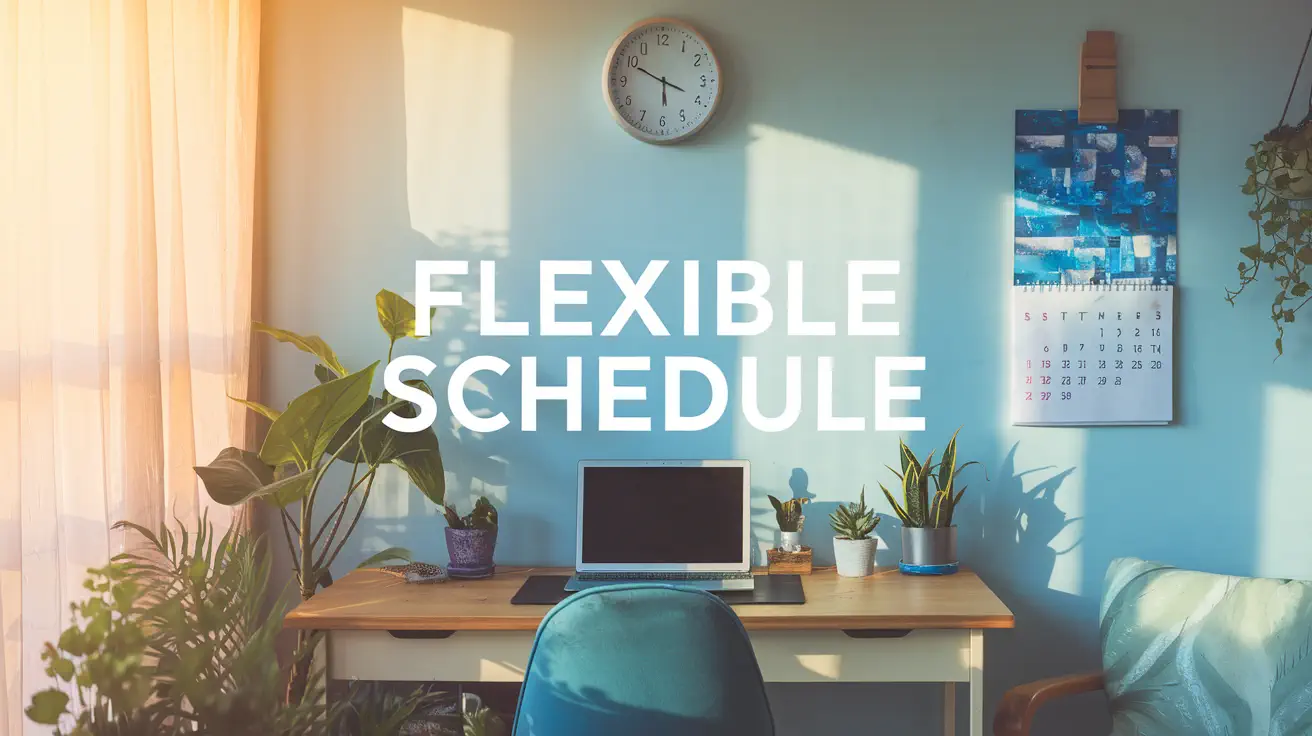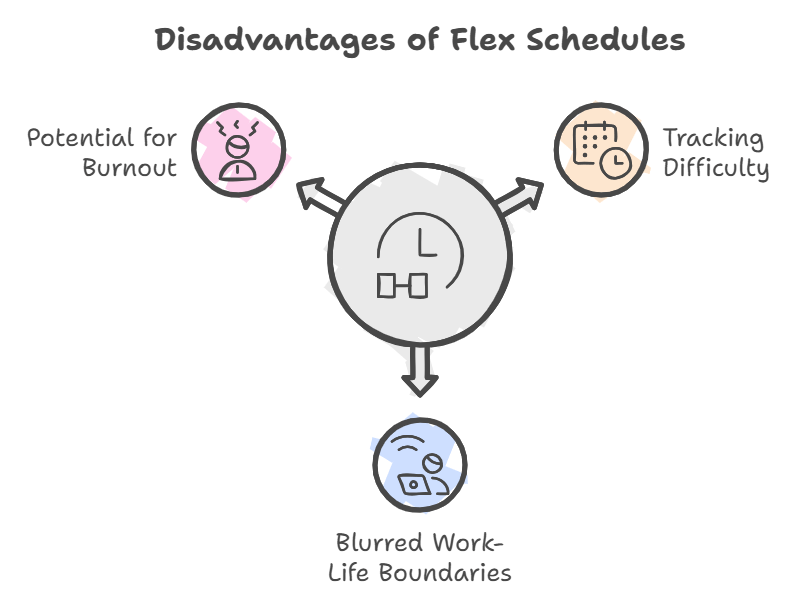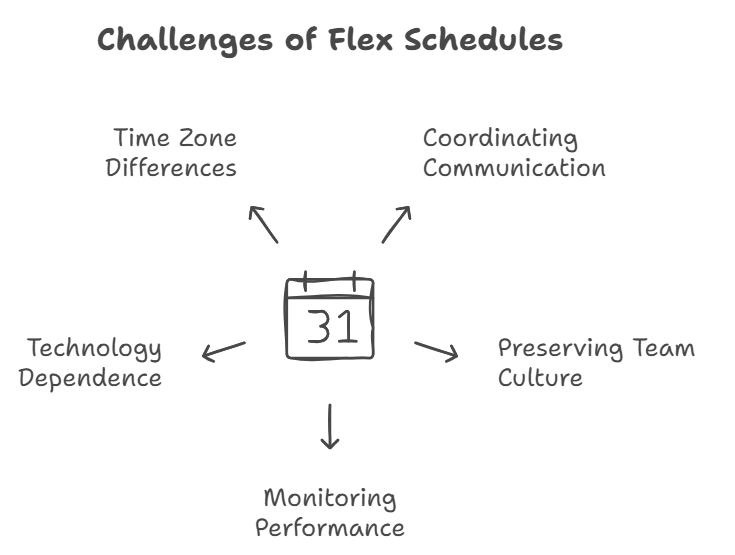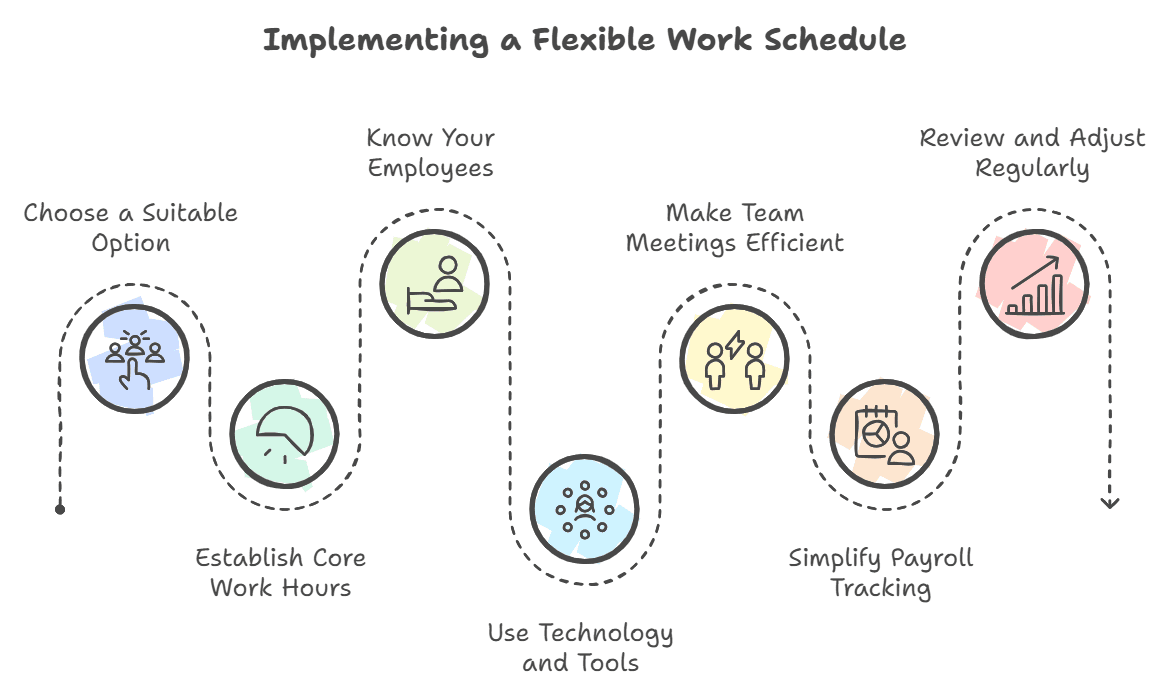Flex Schedule: Everything You Need to Know with Pros and Cons
No Credit Card Required.

Flex schedule allows workers to set hours that suit them, improving health, productivity, and work-life balance. Today, it’s changing the way we work.
For employees, they can help them balance work and personal life better. For employers, they can be a great way to increase productivity and attract the best workers.
With 81% of workers preferring flexible hours, it's a win-win solution. So, for that reason, I’ll discuss —
- What flex schedule is and its benefits
- Types of flexible work arrangements
- How to implement a flex schedule
- Challenges and solutions
- Real-world examples from top companies
Let's make your day better. Ready to start?
What is a Flex Schedule?
A flex schedule is outside the traditional 9-to-5 routine, where employees can set work hours that suit their personal and work lives. This setup may allow workers to choose their shift times, work remotely, or pick specific days to work.
Some roles require as few as 20 hours a month, while others follow set options, like working four long days each week. Also, it could be having core hours where everyone is available.

Advantages of a Flex Schedule
A flex schedule job provides a range of benefits, from improving personal well-being to increasing productivity at work.
For Employees
Let’s first look at the benefits employees usually enjoy from flex schedule remote jobs.

Improves Work-Life Balance
Flexible work hours help employees to choose their work hours to balance their family life and personal interests.
In fact, a study by Harvard Business Review a study by Harvard Business Review found that 88% of workers would rather have flexible work hours than a higher-paying job with fixed hours.
Emily MacIntyre, a former HubSpot manager, says that, while flexible hours are valuable, they come with trade-offs. She sometimes misses after-hours office events to spend evenings with her daughter.
However, for her, that family time is worth the exchange.
Increases Productivity
When employees can choose their work hours, their productivity increases. That’s because they can work when they’re most focused. It helps them work with more energy, finish tasks quickly, and feel less stressed.
Tony Schwartz, who wrote the book 'The Way We’re Working Isn’t Working,' says that working hard without distractions and taking regular breaks is the best way to get good results.
Remember, not everyone’s internal rhythm matches the typical 9-to-5.
Happier at Work
I believe that flexible work schedules can make a big difference in how happy we are at our jobs.
For example, a study in the UK found that 82% of people with flexible hours are satisfied with their jobs. Plus, 67% say they have a good balance between work and their personal lives.
Better Health
Having a flexible work schedule can make a real difference in health. If my employee gets sick and needs to see a doctor or take a break, they can change their work hours.
Flex schedule removes the burden of worrying about taking time off. If someone isn't feeling well, they can choose to work from home effectively or do their tasks later in the day to get more rest.
For Employers
Steve Glaser, CEO of ComfortZones Digital, said, 'When you give employees freedom, you show that you trust them to do their best work.'
He continued, 'The more you support this freedom, the more employees will feel like they're in charge of their jobs. It’ll make them more responsible and take more ownership.'
So, here are some benefits for employers from using a flex schedule.

Attracts and Retains Top Talent
People are looking for jobs that fit their lives, not just traditional office hours. In fact, research shows that many job hunters now prefer flexible work hours over traditional benefits.
They want to decide when and where they work. Plus, 83% of businesses have either started offering flexible hours or are planning to do so soon.
Positive and Motivated Employees
When employees and the employer have flexible work hours, they can spend time on things they love that don't fit into a regular 9-to-5 job. I've seen how this can be helpful.
When employees and the employers have flexible work hours, they can spend time on things they love that don't fit into a regular 9-to-5 job. I've seen how this can be helpful.
For example, they might take a cooking class in the afternoon or volunteer at a local charity during the week. Doing things they enjoy makes them feel happy and motivated, which helps them work better.
Further Read: Practical Tips to Motivate Employees Who Work Remotely.
Improves Employee Morale
Flexible work hours can have a lasting impact on morale. Allowing employees to handle personal needs—whether it’s childcare, studying, or avoiding rush hour—can help them feel supported and less stressed.
Over time, this freedom can lead to greater job satisfaction and a healthier outlook on work.
Disadvantages of a Flex Schedule
While flex schedules offer many perks, they come with potential drawbacks. They’re —

Tracking Difficulty
With flexible schedules, keeping track of employee hours can be challenging. Employees may come in early or leave late, making it hard to monitor their hours and avoid issues like time theft.
That said, employers can follow the best ways to track time to overcome this obstacle.
Blurring of Work-Life Boundaries
Working from home makes it tough to separate work from personal life—I’ve been there.
It’s easy to get distracted by kids, pets, friends, or other things around the house. In this case, there are different types of work schedules that you can explore. Choose one that fits you.
Potential for Burnout
Burnout can stem from constant change and a lack of routine. Sometimes, too much change and a lack of routine can lead to this.
The Fair Labor Standards Act says that workers who work more than 40 hours in a week should get extra pay. Ultimately, it leads to burnout, right?
To prevent burnout, let employees choose their own work hours and stick to them for a while. Plus, they should learn to apply remote work best practices to stay focused and avoid burnout.
Types of Flexible Schedules
Flexible work hours don't always mean working fewer hours or part-time. Here are some common flexible work schedule options.

1. Working from Home
Ideal for roles like IT and marketing, working from home allows employees to stay focused by avoiding office distractions, whether they’re fully remote or on a hybrid schedule.
2. Compressed Workweek
A compressed schedule means working longer hours over fewer days.
For instance, some may choose —
- 4/10 work schedule (Work 10 hours a day, four days a week).
- 9/80 work schedule (work 80 hours in 9 days, instead of 10 days).
- 2-2-3 work schedule (28 days rotation, 2-day and 3-day work blocks).
Each setup works for different industries. So, you need to figure out which one works for you.
3. Part-Time Employment
Part-time work is often chosen for balancing responsibilities like childcare. It becomes even more appealing with flexible hours. That way, employees can adjust their schedules as needed.
4. Flexible Hours and Flex Time
This approach lets employees choose when they start and end their day. Plus, it offers options to take time off later if they work additional hours. So, there’s room for adjustments while meeting the required hours.
5. Asynchronous Work
Asynchronous schedules are especially useful for global teams. It helps employees to set their own hours, start and stop times, and breaks. Thus, they can collaborate effectively across time zones without fixed schedules.
Further Read: How to Find and Get Remote Jobs.
Challenges of Implementing Flex Schedules
Here are some of the key problems organizations face when implementing flexible schedules —

Coordinating Communication
When people work from home or on different schedules, it's harder to stay on the same page. You need clear ways to communicate to keep everyone informed and make sure deadlines are met.
Preserving Team Culture
Working from home can make employees feel isolated from the company and their coworkers. Without face-to-face interactions in a shared office, it's harder to create a feeling of connection and teamwork.
Monitoring Performance
It's difficult to keep track of what team members are doing in flex schedules. Plus, giving them feedback is another trouble when they work in different places and at different times.
When it comes to tracking, Apploye can help a lot. You can use it to automatically track their time or do it manually. It helps businesses keep accurate records of work hours.
Technology Dependence and Reliability
Working from anywhere requires strong technology. You need tools for management, communication, and a secure network.
Sometimes software glitches or internet breakdowns can slow down workflow. Thus, employees might feel disconnected or frustrated.
Time Zone Differences
When people work in different time zones, scheduling meetings or coordinating replies can be difficult. You need to put a lot of effort into planning so everyone can contribute without delays.
How to Create and Implement a Flex Schedule Work (as an Employer)
There are a few easy things employers can do to make flexible schedules work well for their company. They’re —

- Choose a Suitable Option: Pick from flexible hours, compressed weeks, part-time, or remote models based on team needs.
- Establish Core Work Hours: Set 2-3 hours for vital team meetings to keep communication aligned across time zones.
- Know Your Employees: Build trust by understanding employees’ personal commitments and matching tasks accordingly.
- Use Technology and Tools: Rely on work from home apps like Google Calendar, Slack, and Dropbox to manage tasks and communication.
- Make Team Meetings Efficient: Stick to the agenda, keep discussions focused, and end with actionable steps.
- Simplify Payroll Tracking: Use tools like Apploye to manage payroll based on tracked hours.
- Review and Adjust Regularly: Continuously fine-tune the flexible work setup through feedback and adaptability.
Legal and Compliance Issues Associated With Flexible Work Schedules
The Fair Labor Standards Act (FLSA) doesn’t talk about flexible work schedules. However, here are some things I've learned that might be useful —
- I recommend setting up a reliable system to track all work hours accurately. It avoids issues down the line and keeps everyone on the same page.
- Define start, stop, and break times explicitly. It’s one less thing to worry about if everyone knows the guidelines.
- Make sure you’re up-to-date on federal, state, and local minimum wage laws—it’s crucial, especially with a flexible setup.
- Classifying employees correctly as exempt or non-exempt is essential to avoid potential compliance issues.
- Outline paid and unpaid leave options so employees have clear expectations.
- Address how workers' compensation applies within flexible schedules.
On a larger scale, governments are increasingly supporting flexible work. Recently, the Netherlands passed a law making remote work a legal right. It means companies have to think about remote work requests.
Portugal also changed its laws. They now pay employees back for remote work costs. They also have rules about communication after work hours. It helps people balance their work and personal lives.
Why Do Some Companies Have Different Flexible Schedules?
Companies adopt various flex schedules to meet their unique needs and support their teams’ well-being. Besides, different jobs require different setups. For example —
Microsoft
Microsoft offers different ways to work, including where, when, and how you do it. Job listings clearly show the options available, and you can talk about them with our recruiters and hiring managers.
By customizing the options to each job, they help their employees balance work and personal life.
Northrop Grumman
Northrop Grumman offers flexible work options, such as four-and-a-half-day weeks and nine-day fortnights. Plus, they offer remote and hybrid work.
They offer flexible leave options, including 2 weeks of purchased leave and extended parental leave. Northrop Grumman’s flex schedule structure highlights that it’s easy to work for.
Delta Airlines
Delta supports flexible roles with options for job-sharing and part-time work. They also help their employees grow their careers by offering mentorship, training, and leadership development.
The reason for applying this approach is to adapt to the airline industry’s dynamic demands.
Google gives employees flexibility in choosing their work hours, as long as they finish their tasks. They can also work from home or even in a different country, as long as they can connect to the internet.
This approach proves Google’s focus on inclusivity and autonomy. Thus, it attracts top talent who value flexible, self-directed work.
Who are Flex Schedules Ideal For?
Flex schedules are ideal for individuals who benefit from working outside the traditional 9-to-5 setup.
- Parents: Flexible schedules help parents manage family responsibilities.
- Students: A flex schedule for students means they can adjust their work hours around classes.
- Remote Workers: Freelancers and global teams can align work with peak productivity or time zones.
- IT, Content, Customer Service: These roles benefit from flexible schedules due to task-oriented work.
Flexible schedule jobs increase employee satisfaction and widen the talent pool.
How to Find a Flexible Schedule Job
Finding a flexible job can seem tricky, but there are a few reliable ways to make it easier. Here’s a straightforward guide to get you started:
- Try Remote Work Sites: Look at sites like Upwork, FlexJobs, or Tutor.com for remote, part-time, or contract roles. Many of these positions allow flexible hours, letting you choose your schedule.
- Adjust Your Resume for Flexibility: To make your resume fit flexible roles, highlight any remote or independent tasks you’ve handled before. It can show employers you’re capable of working independently.
- Look into Virtual Assistant Jobs: If you have experience in customer service or admin tasks, virtual assistant roles might be a good option. Many of these roles involve handling emails, scheduling, or basic support tasks and can often be found on Indeed or LinkedIn.
- Use Your Network: Reach out to friends, family, or colleagues for help finding flexible work. Often, people you know can recommend roles that aren’t posted online or provide valuable leads.
- Apply Even Without Meeting Every Requirement: For flexible schedule remote jobs, experience often matters more than exact qualifications. If a role seems like a strong match for your skills, go ahead and apply.
- Stay Open and Keep Looking: Finding the right flexible role may take time, especially if you have specific needs. Keep exploring different options like freelance writing, proofreading, or customer support.
Conclusion
Flex schedule has proven to be a game-changer for many companies. They can increase productivity, improve employees' personal lives, and attract the best talent.
But remember, implementing a flex schedule isn't without challenges. Communication, performance tracking, and maintaining team culture require careful planning.
Apploye can help you make the transition to a flexible work environment easier. It’ll ensure that everyone stays on track and connected. Flexible work is the future – are you ready?
FAQs
What is the purpose of a flexible schedule?
The purpose of flexible work schedules is to improve employee satisfaction, health, and work-life balance. It can also benefit employers by increasing productivity, reducing employee turnover, and decreasing absences.
What does flex schedule mean in school?
Flex scheduling in schools is a set period, usually 30 to 45 minutes. Schools can use flex time to give students extra help or let them work on things they need most.
What does a flexible schedule mean in college?
A flexible schedule in college means that students can change their classes every semester to fit their busy lives. It means they can manage school with their job, family, or other goals without sacrificing anything.
What industries use flex scheduling?
Many industries use flexible work schedules. IT is leading the way, with 14% of employees working from home. Advertising and marketing are close behind, with 13% and 12% respectively. Human resources and banking are also popular choices for flexible work.
Do you get paid for flex days?
Yes, many companies offer pay for flex days, depending on the job and company policy. Flex days often mean working longer hours on fewer days, and while employees usually get paid, it’s vital to check specific policies. Some roles offer hourly pay for added flexibility.